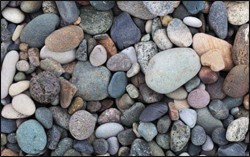Using Gravel to Teach Geology

By Brianne McCurley
A hands-on subject, geology can take students out of the classroom to nearby locations, to learn what rocks are all about. Taking field trips to places such as rock quarries, geology or mineral museums, and sand and gravel operations is a great teaching tool and has been shown to enhance students’ problem solving and critical-thinking skills. Studying gravel is not hugely popular, but using local gravel samples to teach geology can be a cost-effective and easily accessible resource for science classrooms. Local gravel samples can be gathered from parking lots, streams or along highway shoulders.
Sample Gravel Activities:
- Investigate samples and analyze similarities and differences (hardness, color, streak, luster and specific gravity); have students consider where they have encountered these gravels and describe potential uses
- Sort and classify; discuss weathering, erosion and transportation
- Compare chemical composition of gravels and discussion of rock cycle, including the processes by which rocks change from one type into another over time
- Search for fossils addressing geologic time, paleoecology, climate change and extinction of organisms
- Investigate its effectiveness as a filtering device
Gravel is defined by geologists as an accumulation of unconsolidated rock pieces with diameters ranging from 2 to 256 millimeters. Gravel investigations in the classroom can also guide discussions toward climate change, evolution and geologic time, as well as to uses in construction, erosion control and manufacture.
Previous research shows that studying rocks and fossils aid in student comprehension of the biological and geological “big picture.” Rocks, minerals, models and study kits can be purchased from Fisher Science Education at www.fishersci.com.
Did You Know?
- All rocks are made of two or more minerals, but minerals aren’t made of rocks
- Gravel occurs naturally as a weathering product at Earth’s surface
- Pumice is the only rock that floats
Classroom Discussion
- There are four agents of erosion — gravity, wind, glaciers and water. Discuss each agent’s effect on rocks
- What are the three types of rocks? Where does gravel get classified?
